Resistance of Four Rings
A uniform wire of resistance R is cut into four circular rings of equal radius. Rings are then connected such that their centers lie on the vertices of a square (as illustrated in the figure above).
If the equivalent resistance between A and B can be expressed as b a R , where a and b are coprime positive integers, determine the value of a + b .
The answer is 143.
This section requires Javascript.
You are seeing this because something didn't load right. We suggest you, (a) try
refreshing the page, (b) enabling javascript if it is disabled on your browser and,
finally, (c)
loading the
non-javascript version of this page
. We're sorry about the hassle.
1 solution
Moderator note:
In this particular circuit, there is a high degree of symmetry that we can exploit to sidestep some of the calculations and get to some of the findings earlier in the process.
Steven points out that two of the wire sections are dead in that they carry no voltage.
If we were to fold the circuit across an axis of symmetry (as below), we see that those sections are transformed into wires that do not connect to another place in the circuit.
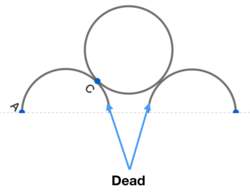 This implies that in the original layout, both of those wire's ends are at the same potential, no current flows down them, and they can be safely ignored.
This implies that in the original layout, both of those wire's ends are at the same potential, no current flows down them, and they can be safely ignored.
From this view, we can also see that the circuit can be simplified to two wire sections in series with a ring. The only adjustment we'd need to make is to replace each circuit element (e.g. the wire sections and the loop) by an equivalent element that is the original element in parallel with itself. In this way, we can offload a little more of the calculation to origami.
Third step is delta to star transformation
Easy question
Log in to reply
No, Steven has used symmetry arguments to simplify the circuit.
I agree that that we can also use the delta star transformation to simplify the circuit. It will yield a slightly different looking intermediate circuit.
Delta star transformation seems a bit overkill when we can directly remove the in-between resistors by symmetry.
Seeing you on brilliant for a while, You are a natural at circuits:)
Log in to reply
Thanks. It's nice to see more circuits problems in the E&M section.
Yeah Delta to star transformation can also be used to simplify the circuit
I found this four kissing circles an interesting setup. Can we generalize this idea to spheres, instead of rings?
Log in to reply
I like the idea. But how do we frame it? Just to explore the concepts, I can think of two separate problems.
1) Two concentric spheres of different radii with a resistive material sandwiched in-between. The spheres themselves could be the two metal electrodes between which we measure the resistance. Here, the electrodes are 2-D surfaces. Since there is nice radial symmetry, it is fairly clear how we would integrate the 4 π r 2 ρ d r spherical slices to get a total resistance.
2) A solid sphere with uniform resistivity. Suppose we wanted to find the equivalent resistance between two 0-D points on the surface. How would the calculation work in this case?
Kissing spheres would be something more akin to (2).
we could do it by folding the circuit about the symmetrical line AB :) can't we sir ? plz tell
I already employed one topological shortcut, which was the symmetry argument that got rid of those middle resistors.
Relevant wiki: Series and parallel resistors
There are four identical rings and the total resistance of them is R . Therefore, the resistance of one of the ring is 4 R .
Now, let us consider one of the rings,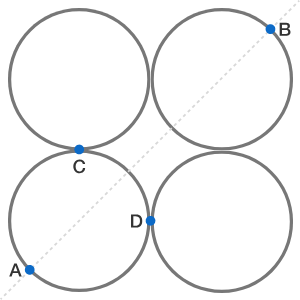
The length of C D is one-fourth whereas the length of both A C and A D are 3 / 8 of the perimeter of the ring. Therefore, the resistance of C D is 1 6 R and of A C and A D are 3 2 3 R .
Similarly, we can for the other rings and draw the following diagram.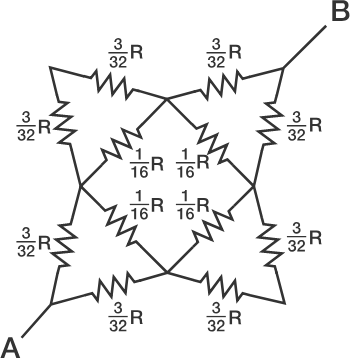
Grouping the resistors in series and parallel, we will get
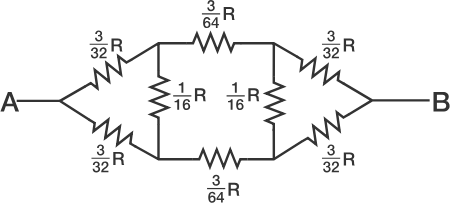
The circuit is symmetric and the top and the bottom branches are identical. Therefore, from symmetry, we can say that the potential drop across the two resistors of 1 6 R is zero. Hence, removing the two resistors and redrawing the circuit.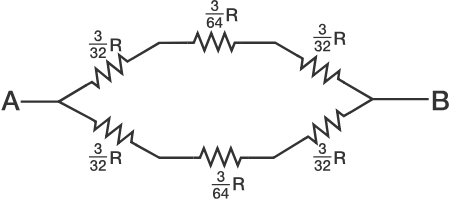
Now, connecting the resistors in one branch in series and resultant of the two branches in parallel, we get
Comparing, b a R = 1 2 8 1 5 R , we get a = 1 5 , b = 1 2 8 . Therefore our answer, a + b = 1 4 3 .